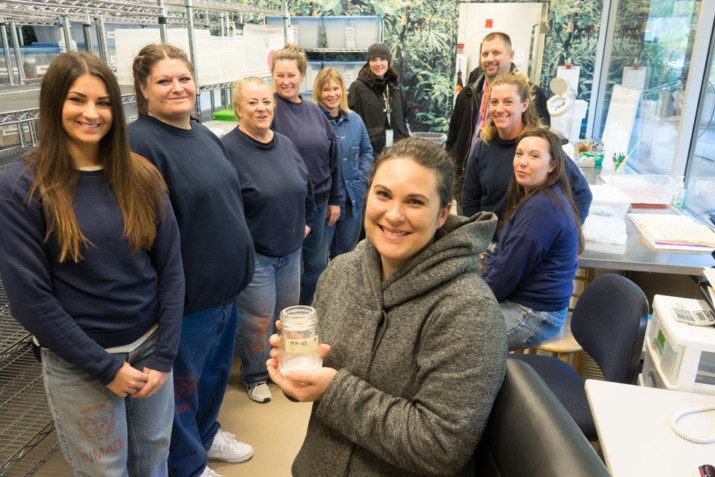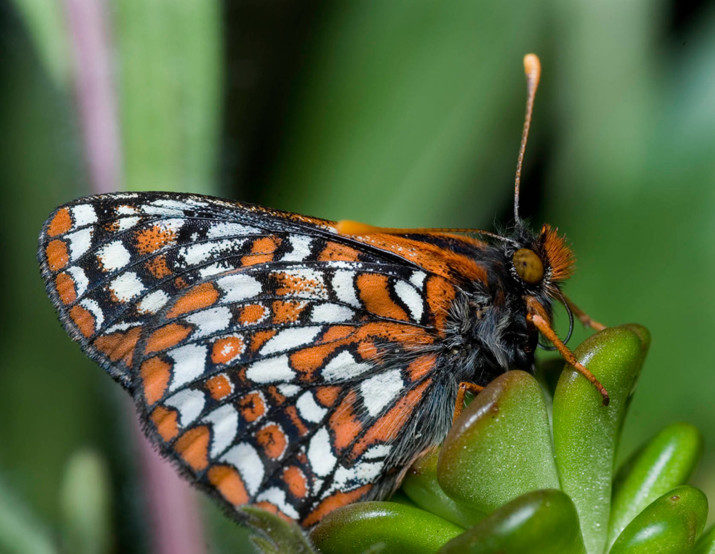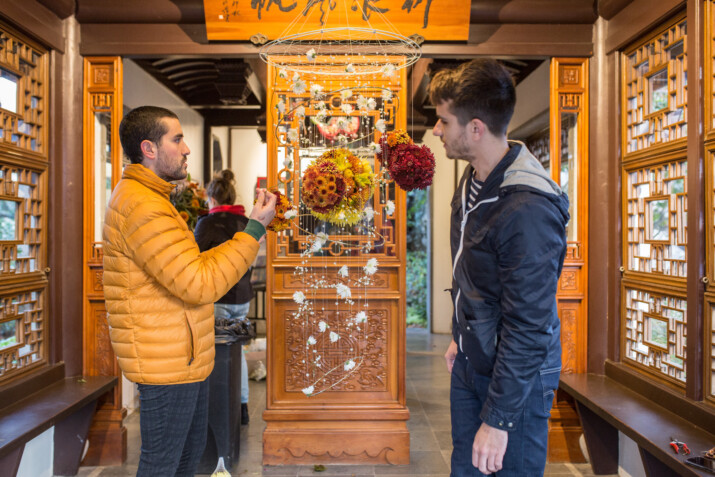Wilsonville, OR. “When I go to our butterfly lab, I feel a sense of peace in a world of chaos,” said inmate Sarah Martin, one of the Coffee Creek butterfly technicians. “I have a rare opportunity to sustain the life of an endangered species, which gives me a unique reward of being able to give peace back into the world.” For much of the past year, the female inmates at Coffee Creek have raised and cared for Taylor’s checkerspot butterfly larvae, as part of a collaboration with the Oregon Zoo and the U.S. Fish and Wildlife Service. Butterfly keeper Julia Low (foreground) held a jar of tiny butterfly larva during a tour of Coffee Creek facility where inmates work in the Butterfly Lab. (Photo credit, Michael Durham.)
Last week, they transferred 562 of the growing caterpillars back to conservation biologists at USFWS for release on western Oregon prairies near Corvallis. It is the first attempt to re-establish Taylor’s checkerspots in Oregon, where only two known populations of this rare Northwest butterfly remain.
“This is groundbreaking,” said Oregon Zoo butterfly conservationist Ronda Naseth, who advises the program at Coffee Creek. “It adds captive rearing and release in Oregon to recovery efforts for the endangered Taylor’s checkerspot butterfly. And it brings butterfly conservation work into a medium-security housing unit for the first time.”
Coffee Creek’s butterfly conservation lab launched last May, with funding from USFWS and the help of an Oregon Zoo Foundation grant. Zoo staff taught inmates how to care for butterfly eggs and raise larvae, supporting their efforts along the way.
Rearing the rare butterflies comes with many challenges. One of the most difficult tasks is feeding the ever-munching larvae, which require vast quantities of specific plants. The Institute for Applied Ecology assists the lab in supplying, propagating and harvesting plantago plants for this purpose. The level of care is crucial: The species is listed under the U.S. Endangered Species Act and, according to Xerces Society for Invertebrate Conservation, is in imminent danger of extinction.
“We set a first-year goal for the facility of 500 larvae, so we were very excited to have met and exceeded that goal,” Naseth said.
The Coffee Creek–reared caterpillars will complete their development in the wild, first turning into chrysalides and then — over a span of warm, sunny days this spring — emerging as adult butterflies and unfurling for the first time their distinctive, colorful wings.
Though once abundant across the inland prairies of the Pacific Northwest, the Taylor’s checkerspot has now lost 99 percent of its grassland habitat to successional plant growth, agriculture and urban development. And while the butterflies themselves are small, the restoration of their high-quality native prairie habitat also benefits a multitude of other species associated with this ecosystem.
The Oregon Zoo has raised nearly 25,000 checkerspots for release since joining the recovery effort in 2004 — including 425 larvae transferred to the Washington Department of Fish and Wildlife last month for release in the south Puget Sound area, where some of the region’s best prairie habitat remains. Another 350 larvae stayed behind to complete their transformation into adult butterflies at the zoo — a “rear guard” of sorts that will breed, lay eggs and produce caterpillars for release next year. Once the work of these 350 is complete, they too will be transferred to WDFW as adult butterflies and released to field sites around the middle of May.
The Oregon Zoo is a charter member of the Association of Zoos and Aquariums’ Butterfly Conservation Initiative, a collaborative effort among nearly 50 zoos and aquariums. The zoo works in partnership with and receives funding from the Washington Department of Fish and Wildlife to rear checkerspots for release into the wild. Additional project partners include Joint Base Lewis-McChord, the U.S. Fish and Wildlife Service, the Xerces Society, the Institute for Applied Ecology, the Sustainability in Prisons Project, The Evergreen State College, Washington Department of Corrections, and the Oregon Department of Corrections.
To learn more about the Oregon Zoo’s effort to save Taylor’s checkerspots and other imperiled Northwest species, visit oregonzoo.org/recovery.
As part of the Metro family, the Oregon Zoo helps make greater Portland a great place to call home. Committed to conservation, the zoo is currently working to save endangered California condors, Oregon silverspot and Taylor’s checkerspot butterflies, western pond turtles and Oregon spotted frogs. Other projects focused on saving animals from extinction include studies on polar bears, orangutans and cheetahs.
Support from the Oregon Zoo Foundation enhances and expands the zoo’s efforts in conservation, education and animal welfare. Members, donors and corporate and foundation partners help the zoo make a difference across the region and around the world.
The zoo opens at 9:30 a.m. daily and is located five minutes from downtown Portland, just off Highway 26. The zoo is also accessible by MAX light rail line. Visitors who travel to the zoo via MAX receive $1.50 off zoo admission. Call TriMet Customer Service, 503-238-RIDE (7433), or visit trimet.org for fare and route information.

















